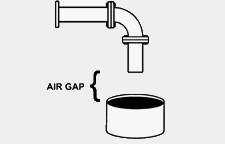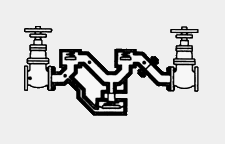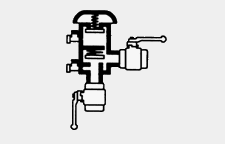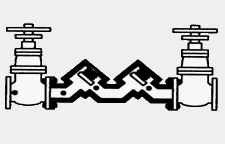Backflow is the undesirable reverse flow of non-potable (non-drinkable) water or other substances that can contaminate the drinking or public water system due to a cross connection in the piping. Preventing backflows is important for protecting drinking water quality.
Austin Water administers a backflow prevention program in conjunction with federal, state and local codes to ensure backflow prevention devices are installed and maintained where backflow may be a risk.
- How Backflows Happen
-
Water delivery relies on pressure; it always takes the path of least resistance as it travels through the water system from high to low pressure areas. Normally, water travels in one direction, from treatment plants, through water mains, then to each customer’s service connection. Certain pressure loss incidents, such as a water main break or fully opened fire hydrant, can force water back into the drinking water system.
Customer water can be exposed to chemicals, microbes and other harmful substances through sinks, irrigation systems, toilets, showers, washing machines, hose bibs, or through commercial fixtures including boilers and cooling towers. Some appliances have built-in backflow prevention for this reason, but many do not. Potential contamination can make extra protection necessary for landscape irrigation systems, spas, swimming pools, solar water heating systems, or even a bucket of soapy water being filled by a garden hose.
- Backflow Types
-
Backpressure backflow caused by downstream pressure that exceeds the upstream supply pressure in the drinking or public water systems due to a high pressure source. This could be caused by pumps, boilers or storage tanks.
Back-siphonage backflow caused by a negative pressure (i.e., a vacuum or partial vacuum) in the drinking or public water system. It can occur when water use exceeds normal delivery capacity of the water supply (e.g., a nearby fire fighting or a water main or service pipe break).
- Backflow Prevention Assemblies Types
-
Backflow prevention assemblies can reduce or eliminate backflows by segregating drinking and non-potable water piping. This is done either by providing an air gap or by installing a backflow prevention assembly (BPA) between the two plumbing systems.
Air Gap 
- Vertical, physical separation between the end of a water supply outlet and the flood-level rim of a receiving vessel
- Separation must be at least twice the diameter of the water supply outlet and never less than one inch
- Effective against backpressure backflow and back-siphonage and may be used to isolate health or non-health hazards.
Reduced-Pressure Backflow Assembly (RBPA) 
- Includes two independently acting, spring-loaded check valves with a hydraulically operating, mechanically independent, spring-loaded pressure differential relief valve in between
- Effective against backpressure backflow and back-siphonage and may be used to isolate health or non-health hazards.
- Required to be testable
Pressure Vacuum Breaker (PVB) 
- Consists of an independently acting, spring-loaded check valve and an independently acting spring-loaded, air inlet valve.
- May be used to isolate health or non-health hazards, but is effective against back-siphonage only.
- Required to be testable
Double Check Valve Assembly (DCVA) 
- Consists of two independently acting, spring-loaded check valves
- Effective against backpressure backflow and back-siphonage, but should be used to isolate only non-health hazards
- Required to be testable
- Backflow Prevention Assemblies Installation & Test and Maintenance Requirements
-
Typically, backflow prevention assemblies are required for plumbing system connections that contain industrial fluids or chemicals, irrigation systems, fertilizers, or auxiliary water sources (including reclaimed water). These devices are subject to annual inspection, maintenance, testing and reporting requirements to ensure each device continues to protect against cross connections. Backflow prevention assembly (BPA) requirements are determined by plumbing inspections performed at initial or remodel construction projects during the Building Permit Process.
Installation
It is important that the BPA match the location’s particular hydraulic conditions and is suitable to protect against the degree of hazard present. Any BPA installed must be a design approved and listed by University of Southern California Foundation for Cross Connection Control and Hydraulic Research (see our Approved Backflow Prevention Assemblies List). Also, the BPA must be installed according to the most recent plumbing code adopted by the City of Austin.Testing and Maintenance
Once installed, these BPAs are subject to initial and periodic testing and maintenance requirements to confirm their continued operational effectiveness. Such testing must be performed by a state licensed Backflow Prevention Assembly Tester (BPAT) registered with the City of Austin. Licensing, registration and other tester-specific information is also available online (see BPAT Information). - Backflow Prevention for Reclaimed Water Customers
-
To test backflow prevention assemblies (BPAs) in the Austin Water distribution area, Backflow Prevention Assembly Testers (BPATs) must be licensed by the Texas Commission on Environmental Quality (TCEQ) and registered with Austin Water.
BPATs are trained to test and repair backflow prevention assemblies and play an important role in protecting the public water system.
Backflow Prevention Assembly
The appropriate backflow prevention assembly depends on the water use.
- Fire line connections can use a double check valve assembly, which can be installed underground in a vault.
- A reduced pressure backflow assembly is required for the domestic potable water connection.
These are installed above ground. Freeze protection for above ground backflow prevention assemblies prevents them from being damaged during cold winter weather.
Cross-Connection
A cross-connection test is required to ensure that on-site potable water plumbing was not inadvertently connected to the reclaimed water plumbing.
Testing
Testing is performed prior to receiving service and are conducted by a third party who submits testing results to Austin Water.

